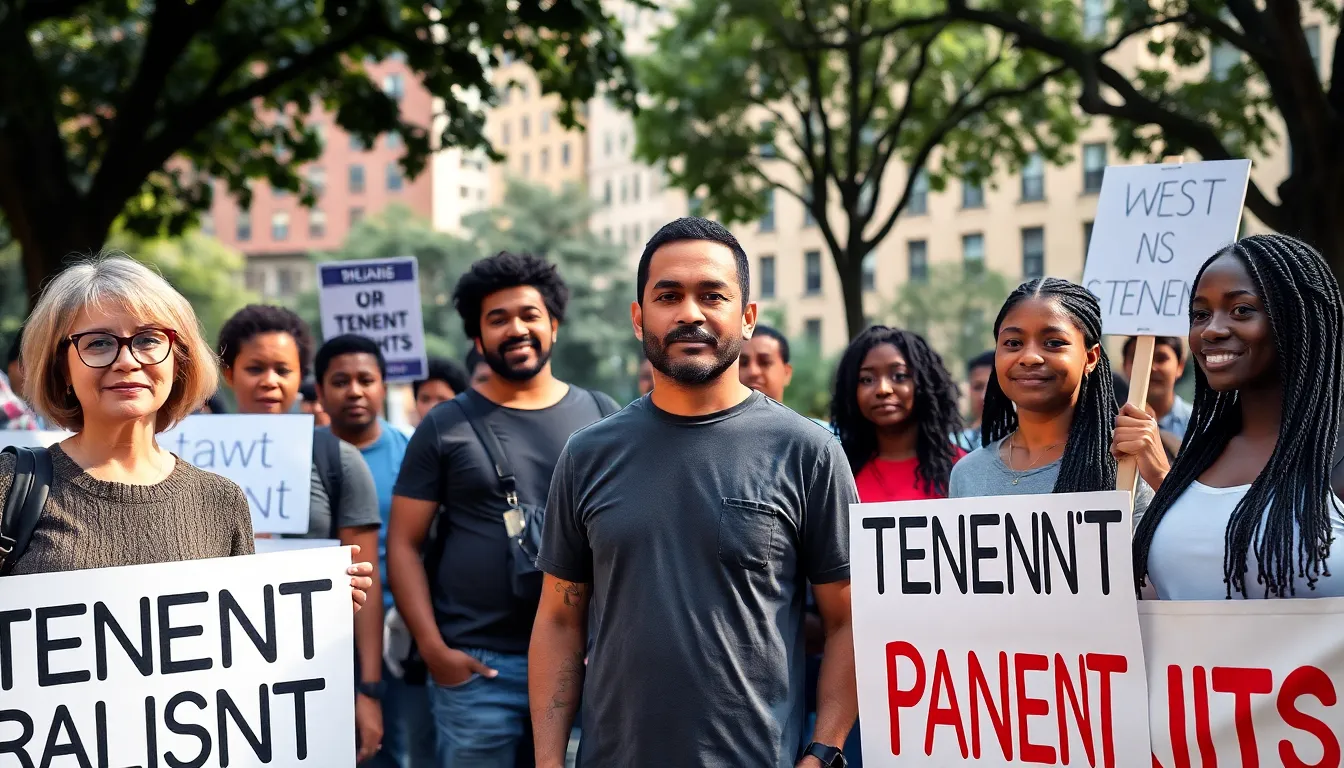Navigating the rental market can feel like a game of dodgeball, where every landlord is a potential ball-thrower and tenants are just trying to avoid getting hit. Fortunately, city-specific tenant protections are like a comfy safety net, designed to catch renters before they hit the ground. These local laws vary from one city to another, offering unique shields against unfair practices and ensuring that tenants have a fighting chance in the housing arena.
Understanding these protections isn’t just smart; it’s essential. Whether it’s avoiding surprise rent hikes or ensuring a safe living environment, knowing the rules can empower tenants to stand their ground. So grab your popcorn and get ready to dive into the world of tenant rights, where knowledge truly is power—and sometimes, a little humor helps lighten the load.
Table of Contents
ToggleOverview of City-Specific Tenant Protections
City-specific tenant protections vary widely, often reflecting local housing markets and community needs. Many cities enact laws that limit rent increases, ensuring affordability for residents. Local jurisdictions may also provide protections against unjust eviction practices, granting tenants stability in their homes.
Various municipalities implement rules for tenant notifications regarding lease changes or rent hikes. Such regulations often require landlords to provide ample notice, ensuring tenants are informed of changes that affect their living situations. In some instances, cities offer rental assistance programs to support those facing financial hardships.
Cities also address habitability issues through specific health and safety codes. These regulations mandate landlords maintain properties in a livable condition, compelling prompt repairs and upkeep. Tenants can report violations to local housing authorities, which can lead to inspections and enforce necessary corrections.
Moreover, cities frequently establish rent control measures limiting how much landlords can increase rent annually. Such mechanisms protect against sudden spikes in living costs, promoting housing affordability. Many areas provide resources for tenants to navigate these regulations, including hotlines and legal assistance.
Tenants are encouraged to familiarize themselves with their city’s specific laws and protections. Knowledge empowers them to assert their rights effectively. Understanding local regulations translates to better management of rental experiences and contributes to overall community well-being.
Importance of Tenant Protections
Tenant protections play a vital role in fostering a fair and secure rental environment. These regulations safeguard renters against unjust practices and provide essential rights.
Economic Stability for Renters
Economic stability emerges as a primary benefit of tenant protections. Cities with effective tenant laws often witness reduced instances of sudden rent hikes. Stable housing costs allow renters to budget effectively, contributing to overall financial health. Landlords in regions with these protections must follow regulations, ensuring living expenses remain manageable. Programs assisting low-income tenants also enhance economic security, allowing them to sustain housing during challenging times. When renters feel secure in their homes, they spend more on necessities, which stimulates local economies.
Impact on Neighborhoods and Communities
Tenant protections significantly influence the overall health of neighborhoods and communities. When renters know their rights, they become more active participants in community life. Stronger rental regulations often lead to increased tenant engagement, fostering a sense of community. Neighborhoods with stable housing tend to experience improved safety and reduced crime rates. Community resources can thrive when residents aren’t burdened by fear of displacement. Ultimately, robust tenant protections not only secure individual rights but also promote vibrant, thriving communities.
Key Features of City-Specific Regulations
City-specific tenant protections play a crucial role in providing stability and security for renters. These regulations, tailored to local markets, ensure fair treatment and safe living conditions.
Rent Control Measures
Rent control measures limit the extent to which landlords can raise rent, offering tenants predictable housing costs. Many cities implement these laws to prevent sudden increases that could threaten affordability. For instance, jurisdictions like San Francisco and New York City have established caps on annual rent hikes. These controls create an environment where renters can plan their budgets without the stress of unexpected financial burdens. Cities often adjust these measures based on economic conditions, ensuring continued support for low-income tenants.
Eviction Protections
Eviction protections safeguard tenants from unjust evictions, providing essential legal support. Most municipalities require landlords to provide just cause before terminating a lease. Examples include requiring a legitimate reason, such as non-payment of rent or lease violations, to proceed with evictions. Often, cities mandate that landlords follow strict procedures, including advance notice to tenants. These safeguards not only reduce eviction rates but also offer tenants a sense of security in their homes. Additionally, access to legal assistance can help tenants navigate eviction proceedings effectively.
Case Studies of City-Specific Tenant Protections
City-specific tenant protections serve as essential safety nets for renters facing the complexities of the housing market. These laws vary by location, reflecting the unique challenges tenants encounter.
Example: New York City
In New York City, rent stabilization laws limit annual rent increases for certain units, ensuring affordability for millions. This regulation protects tenants from excessive hikes, with financial guidelines established based on building types and tenant incomes. Additionally, this city mandates just cause evictions, compelling landlords to provide valid reasons before terminating leases. Legal support services are readily available, helping tenants navigate housing disputes effectively. Community organizations also advocate for stronger tenant rights and expanding protections in under-served neighborhoods.
Example: San Francisco
San Francisco enforces stringent rent control measures that cap annual rent increases for many residential units, fostering stability. The city’s laws require landlords to issue significant notice periods before evicting tenants, promoting transparency. A unique feature includes provisions for tenant buyouts, which include compensation for those agreeing to vacate their units. Rental assistance programs provide crucial support for low-income renters facing financial hardships, safeguarding them from homelessness. Community engagement initiatives further enhance tenant awareness, ensuring residents remain informed about their rights and available resources.
Challenges and Criticisms
Tenant protections face various challenges and criticisms, often affecting their effectiveness. Local governments sometimes struggle to enforce existing regulations, leading to gaps in tenant support. During enforcement, insufficient funding for housing agencies can limit their ability to provide adequate oversight.
Many landlords argue that these protections hinder their ability to manage properties effectively. They claim that regulations can discourage investment in rental housing, ultimately reducing the availability of affordable units. Critics point to instances where rent control leads to disinvestment in the rental market, causing a deterioration of property conditions.
Some tenants report that the complexity of navigating these protections poses additional hardships. A lack of awareness about rights and available resources can leave many vulnerable to exploitation. Often, legal assistance programs do not have the capacity to serve all tenants in need, leading to unequal access to support.
Data from various cities indicate that while tenant protections can reduce eviction rates, they may not entirely eliminate unfair practices. In New York City, for instance, tenant protections have seen mixed results, with some neighborhoods experiencing continued affordability crises despite robust regulations. Critics argue that the bureaucratic nature of these protections can create delays and frustration for tenants trying to find relief.
Community engagement remains a crucial component in addressing these challenges. Educational initiatives may empower tenants with knowledge, equipping them to advocate for their rights. Without ongoing support and improvements to tenant protections, the challenges and criticisms will continue to shape the conversation around housing stability.
Conclusion
City-specific tenant protections play a pivotal role in creating a fair rental landscape. They not only shield tenants from unjust practices but also promote economic stability within communities. By understanding and utilizing these protections, renters can navigate their rights more effectively and foster a sense of security in their homes.
As cities continue to adapt their regulations to meet local needs, ongoing engagement and education remain essential. Empowering tenants with knowledge about their rights can help combat challenges and criticisms surrounding these protections. Ultimately, robust tenant laws contribute to healthier neighborhoods and a more equitable housing market for all.









